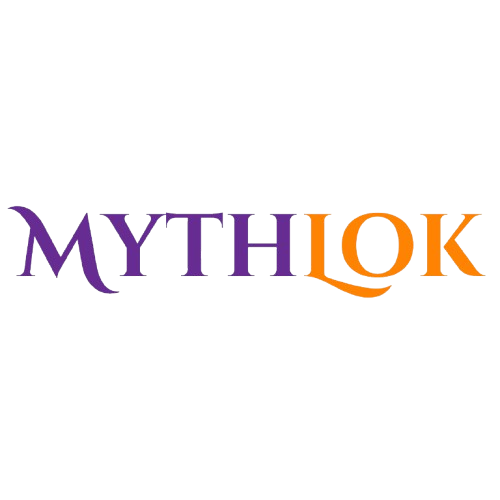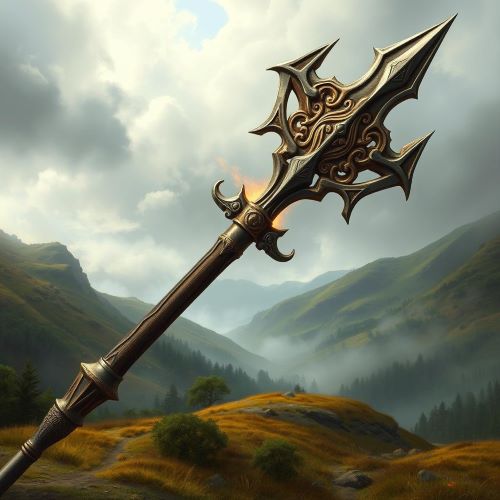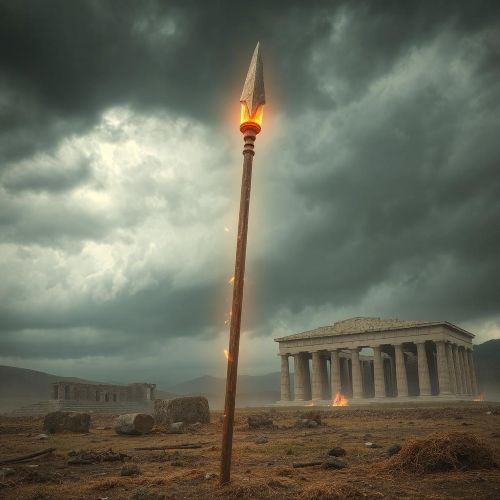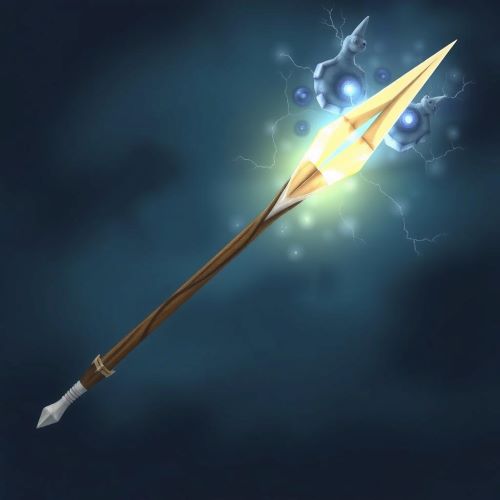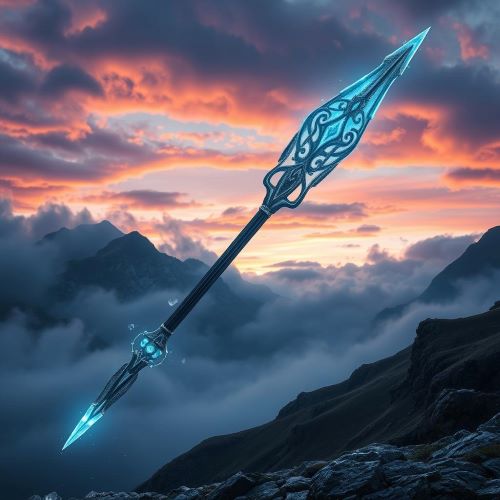Gae Assail : The Lightning Spear
Gae Assail
Introduction
Celtic mythology is a treasure trove of powerful deities, heroic tales, and enchanted objects. Among its legendary weapons, the Gae Assail—also known as the “Spear of Assal” or the “Lightning Spear”—stands out as a symbol of divine justice and supernatural warfare. Unlike many ordinary tools of battle, this spear occupies a revered position in Irish myth, serving both as a literal weapon and a metaphorical beacon of sovereignty and destiny. Deeply rooted in the lore of the Tuatha Dé Danann, the Gae Assail exemplifies the mysticism and grandeur associated with ancient Celtic storytelling.
Origins
The story of Gae Assail begins in Gorias, one of the four mystical cities linked to the Tuatha Dé Danann, an otherworldly race of skilled warriors and magicians in Irish legend. Each of these cities contributed a treasure to Ireland, and from Gorias came the Gae Assail. This mythical weapon wasn’t merely forged in fire but seemingly infused with cosmic power.
The name “Gae Assail” has been interpreted as “Spear of the Air” or “Sky Spear,” indicating its ethereal nature and lightning-speed trajectory. It was originally associated with a figure named Asal, from whom the spear got its title. Later, it came into the possession of Lugh, the radiant god of many talents. The acquisition of Gae Assail by Lugh was no accident—it was a result of divine law and restitution, adding a layer of cosmic justice to its legacy.
Think you know your myths and legends? Dive into the world of ancient stories and test your knowledge with our engaging quizzes on Mythlok!
Powers
What sets the Gae Assail apart from other mythological weapons are its extraordinary and often terrifying powers. Described as a spear that “never missed” and “always returned,” it was a flawless instrument of divine will. It was said to possess a mind of its own—so eager for battle that it had to be subdued when not in use.
Ancient accounts describe how the spear would burst into flames from its tip, needing to be stored in a vat of water or drugged with poppy-infused concoctions to prevent uncontrollable bloodlust. Its accuracy was guaranteed by incantations: shouting “Ibar” ensured it struck its mark, while “Athibar” called it back to the hand of its master. These verbal commands speak to the Celtic belief in the power of words and magic combined.
In essence, Gae Assail was not just a tool of war—it was a living force, one that embodied divine retribution, lightning-fast justice, and unerring resolve.
Owners/Users
The most famous wielder of Gae Assail is Lugh Lámhfhada, whose name means “Lugh of the Long Arm.” A deity of kingship, craftsmanship, and warfare, Lugh was among the most revered figures in Celtic tradition. As a central member of the Tuatha Dé Danann, he wielded Gae Assail with unmatched skill, particularly in battles where divine intervention was needed.
Before Lugh, the spear belonged to Asal, a mysterious figure who may have been a guardian or earlier godlike character. Some traditions suggest that the spear was acquired by Lugh as a form of compensation (or éric) from the children of Tuirill Piccreo, underlining its status as a sacred and earned possession.
While Cú Chulainn is more closely associated with the Gáe Bolg, his paternal lineage sometimes ties him back to Lugh. In fragmented versions of Irish folklore, there’s speculation that he may have come into contact with Gae Assail through ancestral or heroic succession, but these are more interpretive than canonical.
Instances used
Gae Assail’s mythological legacy shines brightest during the Second Battle of Mag Tuired, where the Tuatha Dé Danann faced off against the monstrous Fomorians. During this climactic showdown, Lugh used the spear to kill Balor, the Fomorian king with a deadly eye that could annihilate armies with a single glance.
Lugh’s masterful use of the spear in this moment is often interpreted as the turning point of the battle, where light triumphed over darkness and balance was restored to the land. The slaying of Balor wasn’t just a physical act—it was a spiritual victory that reinforced Lugh’s legitimacy and the righteousness of the Tuatha Dé Danann.
There are also tales suggesting that the spear played a role in rituals of kingship and governance. Possession of Gae Assail was more than military power—it was a sign of divine approval, a tool that legitimized leadership and symbolized rightful sovereignty.
Frequently Asked Questions
Lorem ipsum dolor sit amet, consectetur adipiscing?
Lorem ipsum dolor sit amet, consectetur adipiscing elit. Praesent convallis vestibulum justo, ac tincidunt nunc vehicula quis. Nullam id dolor quis orci malesuada feugiat. Curabitur aliquet libero at urna ullamcorper, ac ultricies nulla dapibus.
Lorem ipsum dolor sit amet, consectetur adipiscing?
Lorem ipsum dolor sit amet, consectetur adipiscing elit. Praesent convallis vestibulum justo, ac tincidunt nunc vehicula quis. Nullam id dolor quis orci malesuada feugiat. Curabitur aliquet libero at urna ullamcorper, ac ultricies nulla dapibus.
Lorem ipsum dolor sit amet, consectetur adipiscing?
Lorem ipsum dolor sit amet, consectetur adipiscing elit. Praesent convallis vestibulum justo, ac tincidunt nunc vehicula quis. Nullam id dolor quis orci malesuada feugiat. Curabitur aliquet libero at urna ullamcorper, ac ultricies nulla dapibus.
Lorem ipsum dolor sit amet, consectetur adipiscing?
Lorem ipsum dolor sit amet, consectetur adipiscing elit. Praesent convallis vestibulum justo, ac tincidunt nunc vehicula quis. Nullam id dolor quis orci malesuada feugiat. Curabitur aliquet libero at urna ullamcorper, ac ultricies nulla dapibus.
Lorem ipsum dolor sit amet, consectetur adipiscing?
Lorem ipsum dolor sit amet, consectetur adipiscing elit. Praesent convallis vestibulum justo, ac tincidunt nunc vehicula quis. Nullam id dolor quis orci malesuada feugiat. Curabitur aliquet libero at urna ullamcorper, ac ultricies nulla dapibus.
Watch
Source
Cartwright, M. (2021). Lugh. World History Encyclopedia. https://www.worldhistory.org/Lugh/
CelticMyths. (2024). The Weapons of Lugh: A Look at the Gae Assail and More. https://celtic.mythologyworldwide.com/the-weapons-of-lugh-a-look-at-the-gae-assail-and-more/
Echevarria, S. (2024). The Spear of Lugh: The Warrior’s Path in Irish Myth. https://celtic.mythologyworldwide.com/the-spear-of-lugh-the-warriors-path-in-irish-myth/
World Mythos. (2024). Gae Assail. https://worldmythos.com/gae-assail/
Wikipedia contributors. (2024). Lugh. Wikipedia. https://en.wikipedia.org/wiki/Lugh

